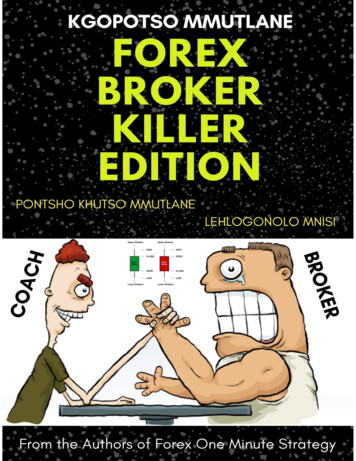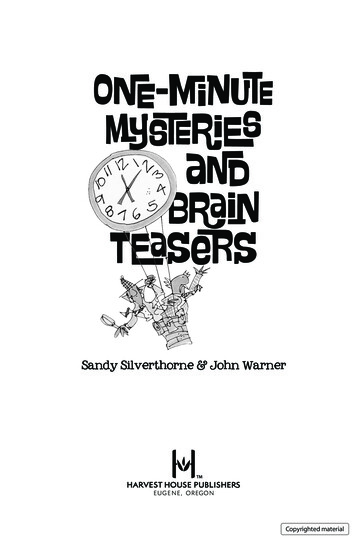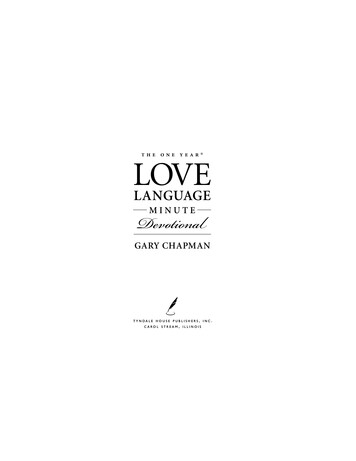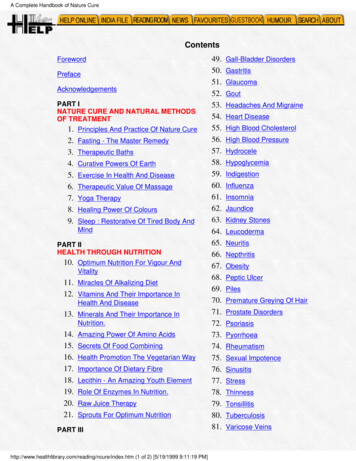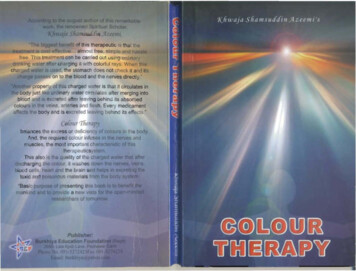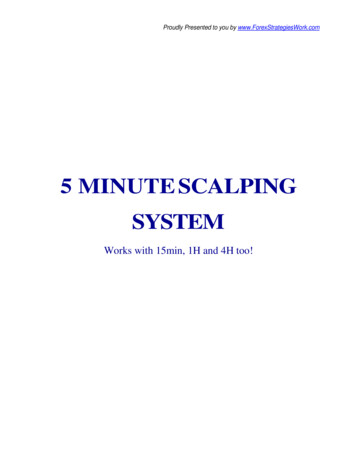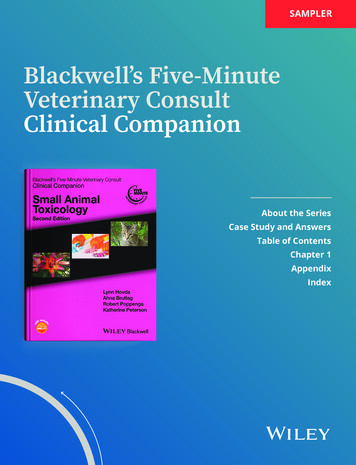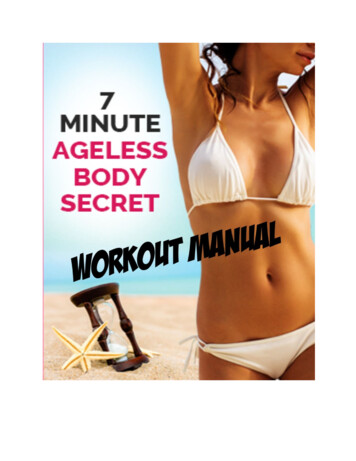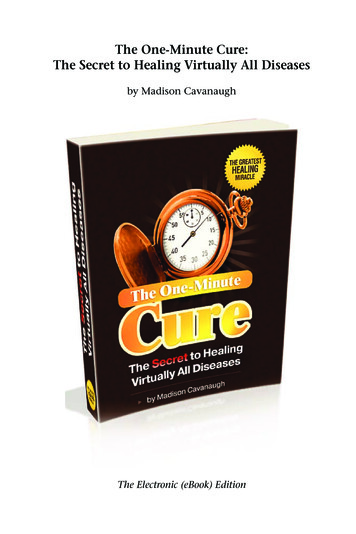
Transcription
The One-Minute Cure:The Secret to Healing Virtually All Diseasesby Madison CavanaughThe Electronic (eBook) Edition
The One-Minute Cure: The Secret to Healing Virtually All DiseasesCopyright 2008 Think-Outside-the-Book Publishing, Inc.No part of this publication may be reproduced, stored in aretrieval system or transmitted in any form or by any means,electronic, mechanical, photocopying, recording or otherwisewithout the written permission of the publisher.Publisher:311 N. Robertson Boulevard, Suite 323Beverly Hills, California claimer: The entire contents of this book are based upon researchconducted by the author, unless otherwise noted. The publisher and theauthor, the distributors and bookstores, present this information foreducational purposes only. We are not making an attempt to prescribe anymedical treatment and the information contained herein is not intended toreplace a one-on-one relationship with a doctor or qualified health careprofessional. Therefore, the reader should be made aware that this informationis not intended as medical advice, but rather a sharing of knowledge andinformation from the research and experience of the author. Think-Outsidethe-Book Publishing, Inc. and the author encourage you to make your ownhealth care decisions based upon your research and in partnership with aqualified health care professional. You and only you are responsible if youchoose to do anything based on what you read.
TABLE OF CONTENTS Introduction . . . . . . . . . . . . . . . . . . . . . . . . . . . . . . . . . . . . . . . . 1Chapter 1Disease is Big Business: The Awful Truth . . . . . . . . . . . . . . 15Fictitious Diseases Abound . . . . . . . . . . . . . . . . . . . . . . . . . 19Nutrition is Big Business, Too . . . . . . . . . . . . . . . . . . . . . . . 22Wonder Cure or Snake Oil? . . . . . . . . . . . . . . . . . . . . . . . . . 31Chapter 2The Most Dreaded Diseases of All Time . . . . . . . . . . . . . . . 39What is Oxygen Therapy? . . . . . . . . . . . . . . . . . . . . . . . . . . 41Why Does Oxygen Therapy Work So Well? . . . . . . . . . . . . 43Ozone and Hydrogen Peroxide . . . . . . . . . . . . . . . . . . . . . . 47Chapter 3Therapeutic Use of Hydrogen Peroxide: A Brief History . . . 56Current Applications . . . . . . . . . . . . . . . . . . . . . . . . . . . . . . 59Hydrogen Peroxide as An Alternative to Interferon . . . . . . 62Will Hydrogen Peroxide Make PeriodontalSurgery Obsolete? . . . . . . . . . . . . . . . . . . . . . . . . . . . . . . . . 62The Solution to Alcoholism . . . . . . . . . . . . . . . . . . . . . . . . 63Reversing Everyday Brain Damage . . . . . . . . . . . . . . . . . . . 64What Doctors Are Saying . . . . . . . . . . . . . . . . . . . . . . . . . . 66
Chapter 4Home Use of Hydrogen Peroxide . . . . . . . . . . . . . . . . . . . . 71Internal Use of Hydrogen Peroxide . . . . . . . . . . . . . . . . . . . 73Intravenous Injection of Hydrogen Peroxide . . . . . . . . . . . 77Making a 3% Hydrogen Peroxide Solution . . . . . . . . . . . . . 79The Gums and Teeth . . . . . . . . . . . . . . . . . . . . . . . . . . . . . . 80Absorbing Hydrogen Peroxide Through the Skin . . . . . . . . 81Inhalation Method . . . . . . . . . . . . . . . . . . . . . . . . . . . . . . . 82A Word About Anaerobic and Aerobic Bacteria . . . . . . . . . 84Chapter 5Hydrogen Peroxide in Nature . . . . . . . . . . . . . . . . . . . . . . . 87Do I Lack Oxygen? . . . . . . . . . . . . . . . . . . . . . . . . . . . . . . . 90Oxygen and Food Consumption . . . . . . . . . . . . . . . . . . . . 92Chapter 6Why the Controversy? . . . . . . . . . . . . . . . . . . . . . . . . . . . . 97Economic Impact . . . . . . . . . . . . . . . . . . . . . . . . . . . . . . . . 99Why Aren’t We All Using It? . . . . . . . . . . . . . . . . . . . . . . . 100The Biggest Threat to the Pharmaceutical Cartel . . . . . . . 103A World Without Disease . . . . . . . . . . . . . . . . . . . . . . . . . 104AppendixThe Missing Piece in the Healing Puzzle . . . . . . . . . . . . . . 107
INTRODUCTION The information you are about to read in this bookwill not only shock you, but also anger and excite youat the same time. It will shock you because the simpletherapy presented herein may be the closest thing to apanacea that you’ve ever encountered, and yet it has beendeliberately suppressed by those who care less aboutprotecting people’s health than they do about their ownfinancial interests. It will make you angry because you mighthave relatives, friends and loved ones who have sufferedunnecessarily from preventable diseases, or even died,because this information has not been disseminated asvigilantly as it should have been. And lastly, it will exciteyou because the simple therapy which is the subject of thisbook may well be what its supporters call “the world’sgreatest healing miracle of all time.”If you are like most people, you probably find it hard tobelieve that any single therapy, substance or element couldhave such a far-reaching and broad spectrum efficacy whenit comes to curing diseases. You have every reason to beskeptical. You might be thinking, ‘How could anything sosimple actually be the answer to all our complex healthproblems?’But the fact is, simple concepts are often the mostpowerful ones—and yet usually the most ignored. This is1
particularly true in the health care field. Over the last sevencenturies, we as a society have been programmed to regardthe curing or healing of disease as a perplexing andcomplicated science that is best left in the hands of medicalpractitioners. As a result, we’ve come to rely almost exclusively on the information that is dispensed to us by doctorsand health care providers who are themselves usuallyuninformed about alternative healing options that may bebetter for treating diseases than the standard medicaltreatments consisting of drugs, surgery, radiation or othertherapies.What you’re about to learn from this book is a simple,inexpensive therapy that can be self-administered at homein less than a minute—and costs about 1½ cents per day. Anestimated 15,000 European medical doctors, naturopathsand homeopaths have provided this powerful therapy toover 10 million people over the past 70 years to treat over 50different diseases, but in the U.S., it has been relativelyunknown because of reasons that will become clear as youread the rest of this book.Before I reveal what that therapy is, it is necessary topresent an abbreviated history of medicine and how itevolved into the overcomplicated, complex system ofhealing that is practiced today. From this condensedretelling of events, one can glean that the process of ‘curing’disease does not have to be the expensive and often invasiveprocedure it presently is. There is an easier, more organicand far more effective approach to curing disease andmaintaining good health—one that has been obscured by2
the highly complex science (and business) of medicine andpharmaceuticals.Ever since the dawn of medicine centuries ago, misinformation about healing has been propagated to thepublic through various methods. The earliest method used,especially during the Black Death in the 14th and 15thcenturies, was the ‘traditional authority’ approach to scienceand medicine. This consisted of the idea that if a prominentperson declared something to be true, then it must be so—and anything observed to the contrary was regarded as ananomaly.Centuries later, physicians like Ibn al-Nafis (regarded as‘the greatest physiologist of the Middle Ages’) and Vesalius(founder of modern human anatomy) replaced previousdoctrines and discredited many of the theories of ‘traditionalauthorities’ with doctrines derived from their explorationsin physiology and anatomy.Fast forward to the 20th century—evidence-basedmedicine began to emerge, wherein the most effective waysof doing things (also called ‘algorithms of practice’ or ‘bestpractice’) were identified through scientific methods andmodern global information science. The evidence wascollated; standard protocols were developed, and thereafterdisseminated to doctors and healthcare providers. Theproblem with the ‘best practice’ approach is that it served tosuppress all other alternative approaches to treatment.Furthermore, the scientific methods used in drawingconclusions, although seemingly logical and unbiased(therefore, reliable), were actually flawed.3
All scientific experimentation is subject to confirmationbias (or the observer-expectancy effect) to a certain extent.Confirmation bias is an unfair influence found in scientificresearch when a researcher expects a given result, andtherefore, unconsciously manipulates an experiment in orderto find that result. A researcher’s particular ideology,worldview, superstitions, traditions or religion can causehim or her to assign greater weight to some data over otherdata. The human brain has a tendency to fill in the gaps ofwhat it perceives, and oftentimes, a researcher may also bestubborn, unwilling to admit a mistake, or embarrassed byhaving to withdraw a publicly declared belief. Thus, anyconclusions derived from “scientific studies” or “clinicalstudies” are rarely unbiased, and thus, cannot always beregarded as reliable.At present, there exists a confusing array of so-called‘best practices’ for every part of the anatomy, all tainted withbias to one degree or another. This has made the curing ofdiseases seem like a complex and mysterious science with itsown language that is beyond the understanding of the nonmedical population—like the scriptural Tower of Babel thatbrought about a confusion of tongues.What complicates the matter is that the field of medicinehas given rise to a slew of organ-based specializations suchas neurology, cardiology, dermatology, ophthalmology,urology, gynecology, endocrinology, etc.—as well as diseasebased specializations such as oncology (for cancer),gerontology (for diseases of the aging) that each have theirrespective modes of treatment and therapy. The end result is4
a medical model not unlike the legend from India about the6 blind men who encountered an elephant.The Legend of the6 Blind Men and the ElephantThere once were 6 blind men who, uponencountering an elephant, gave their own individual assessments of the elephant. The first onehappened to fall against the broad and sturdy sideof the elephant, and concluded that the elephant isvery much like a wall. The second one, feeling thetusk, said the elephant was very much like a spear.The third one happened to take the squirmingtrunk in his hands, and said the elephant was verymuch like a snake. The fourth one, reached out andtouched the elephant’s knee, and concluded thatthe elephant is very much like a tree. The fifth onehappened to touch the ear, and insisted that theelephant is very much like a fan. And the sixth oneseized the swinging tail, and said the elephant isvery much like a rope. Each of the blind men waspartly right based on his own subjective perception—but at the same time, mostly wrong. The comicalpart of it all is that their dispute stemmed from utterignorance because none had ever seen the elephant!5
The field of medicine, with its compartmentalizedtheories about what causes disease and how to eradicate itfrom the human body, actually perceives only a smallsnapshot of the larger picture, a localized subset of the largerworkings of the human body.One would think that because the medical andpharmaceutical industries have grown as large as they have,that we would have less sick people in the world. But theopposite is actually true. There are more sick people in theU.S., for instance, than at any other time in history—notjust in actual numbers but as a percentage of the population.This, in no way, is intended to discredit doctors,medical practitioners and institutions that have genuinelygood intentions of helping to heal people and eradicatedisease. It simply points to an ineffective medical systemthat is focused on illness rather than wellness, that promotesexpensive (i.e., profit-driven), invasive and potentiallydangerous (or even deadly) medical procedures, drugs ortreatments rather than simple, natural, inexpensive,effective treatments or therapies that have no side effects.There’s a Chinese proverb which says:The superior doctor prevents illness.The mediocre doctor attends to impending sickness.The inferior doctor treats actual illness.According to the above definition, traditional (allopathic) doctors are either mediocre or inferior! However,6
they are so, not necessarily because of their mediocre orinferior dedication to the healing profession, but because all126 medical schools that provide conventional medicaleducation and training focus on treating actual orimpending diseases rather than preventing them.While the majority of drugs prescribed by doctors mayseem to provide relief (or so-called “cure”) for a disease, mostof them simply relieve symptoms or the pain associatedwith the disease, but don’t cure the disease. For example,the most popular asthma medications (consisting of inhaledbeta-agonists), which relax airway muscles, may helpasthma sufferers to breathe easier, but they do NOT cure thecondition nor reduce the inflammation in the airways. Thedrugs that do claim to “cure” an illness by halting the spreadof invading germs, such as bacteria and viruses; and bykilling cells as they divide or preventing them frommultiplying; do so but not without harming the body tosome extent.Practically all drugs have side effects: that is, they causeeffects (including adverse and serious effects) other thanthose that are desired. Sometimes, drugs provide relief forone health problem, but in the process, give rise to evenmore serious health problems. So we take drugs that relievethe symptoms of osteoporosis and in turn, acquire a highrisk of breast cancer; and we trade impotence for heartdisease; or depression for diabetes; and take a pi
he information you are about to read in this book willnotonlyshock you,butalsoanger andexcite you at the same time. It will shock you because the simple therapy presented herein may be the closest thing to a
